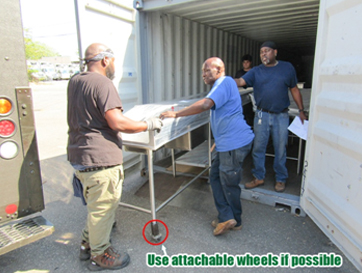How to Properly Handle Stainless Steel

It’s no secret that stainless steel is strong. In fact, stainless steel can be 3 times stronger than standard steel depending on composition. However, stainless steel is not 100% immune to dents, corrosion, scratches or warping. This is where human handling & care comes into play. How can you get the most life out of your stainless steel equipment starting right with initial delivery? We are here to provide some insight.
In this article, we will give you some tips & tricks on handling your stainless steel equipment. We’ll also provide some preventive maintenance & daily care guidelines to help you out. Let’s begin.
Handle with Care
The first tip is to always make sure you have a soft touch. Wear gloves & stay aware of the weight of each item. Setting your equipment down on a rough, jaggy surface is a surefire way to scratch & damage your stainless steel. Try to avoid this if possible.
Instead, have plenty of blankets on hand to smooth out the surfaces to lay your items on. Even if your items are fully wrapped (in plastic or cardboard), you should never set down stainless steel on a coarse surface. Here’s an example of what NOT to do:


Avoid Abrasives at All Costs
Carbon steel & aluminum should be kept separate from stainless steel. Also, loose & embedded iron particles are one of the most common sources of contamination.
Why?
Without getting too scientific, stainless steel is prone to galvanic corrosion. This means when two metals come in contact with each other plus an electrolyte (such as humidity or water), deterioration occurs.
The ultimate solution is to keep all of your stainless steel items grouped together & away from other products made from different types of metal. If this is not possible, you can use an in-between like a rubber material to isolate them.
No Dragging!
Stainless steel can be cumbersome, we know. The temptation is there to drag your items on the floor to transport them. This happens more commonly in products where legs are present.
The truth of the matter is dragging stainless steel across the floor can do severe damage to the underside & can bend legs & bullet feet (if equipped). Instead, have a team ready to pick up the items & place them down gently. If your equipment is modified with casters, then dragging is perfectly fine.
If you have a dolly, attachable wheels, or transport cart, it will make your life much easier. Here are some examples of how to easily transport your stainless steel items without dragging them:



Preventive Maintenance
The standard stainless steel care guidelines will apply. This means no harsh cleaning chemicals & no abrasive cleaning tools. Remember to wipe with the grain as well.
Keep adhesives, oil, paint, grease, chalk & other contaminants away from stainless steel. Adhesives in particular can harden & cause crevice corrosion if the exposure is long enough. The goal is to keep the surface of stainless steel as clean as possible at all times.
Handling stainless steel can be a bit more complicated than you think. In the end, it should be treated with white glove service level care. By developing routine maintenance procedures, you can be sure to extend the overall life of your products. For a closer look at other IMC maintenance tips, click here.




